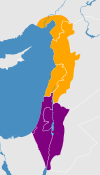South Levantine Arabic (Arabic: اللهجة الشامية الجنوبية, romanized: al-lahja š-šāmiyya l-janūbiyya, South Levantine: il-lahje š-šāmiyye l-jnūbiyye) was defined in the ISO 639-3 international standard for language codes as a distinct Arabic variety, under the ajp code. It was reported by Ethnologue as being spoken in the Southern Levant: Palestinian Territories (the West Bank, including East Jerusalem, and the Gaza Strip), Israel, and most of Jordan (in the Ajlun, Al Balqa, Al Karak, Al Mafraq, Amman, Irbid, Jarash, and Madaba governorates).[1][2]
In 2023, South Levantine Arabic and North Levantine Arabic were merged into a single Levantine Arabic in the ISO,[3] based on the high mutual intelligibility between Arabic varieties spoken by sedentary populations across the Levant and the lack of clear distinctions between variants along national borders.[4]
References[edit]
- ^ Jordan and Syria in Eberhard, David M.; Simons, Gary F.; Fennig, Charles D., eds. (2022). Ethnologue: Languages of the World (25th ed.). Dallas, Texas: SIL International.
- ^ South Levantine Arabic at Ethnologue (25th ed., 2022)

- ^ "Glottolog 4.8 - South Levantine Arabic". glottolog.org. Retrieved 2023-11-06.
- ^ "Request for Change to ISO 639-3 Language Code" (PDF). iso639-3.sil.org.

Well, that’s interesting to know that Psilotum nudum are known as whisk ferns. Psilotum nudum is the commoner species of the two. While the P. flaccidum is a rare species and is found in the tropical islands. Both the species are usually epiphytic in habit and grow upon tree ferns. These species may also be terrestrial and grow in humus or in the crevices of the rocks.
View the detailed Guide of Psilotum nudum: Detailed Study Of Psilotum Nudum (Whisk Fern), Classification, Anatomy, Reproduction